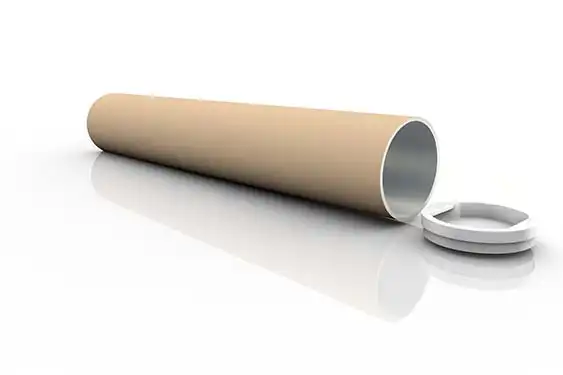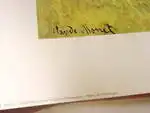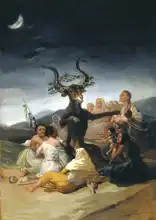About this finishing
Print. The image is printed on the top quality 10-ink HP Z9PS printer on HP matte 270 g / m2 paper. You can choose any size to an accuracy of 1 cm. A margin of 5 cm around the image is added to the size of the motif.


You can find a detailed description about our finishings
here.
Witches
Date:
1798Medium:
oil on canvasLocation:
Museo Lazaro Galdiano, Madrid, ŠpanělskoThe painting depicts a scene from the night with a goat creature standing on its hind legs in the central part. Its horns are decorated with branches and leaves. Around it, people are seen in various positions - some sitting, others kneeling - and appear to be worshipping or sacrificing the creature. A mixture of human figures and the supernatural is depicted, suggesting a possible ritual or ceremony. A crescent moon shines in the sky and the background is dark except for a faint light in the distance.
This description was created by artificial intelligence, please be indulgent.
Goya painted picture Witches in 1798. Prevailing color of this fine art print is dark and its shape is portrait. This art piece is located in Museo Lazaro Galdiano, Madrid, Španělsko. This image is printed on demand - you can choose material, size and finishing.
Francisco de Goya (1746-1828). Born in Spain, the son of a goldsmith. His work is characterized by loose brush strokes, an unprecedented release from the obligation to draw exactly according to reality. His works are among the precursors of many future artistic directions (
Realism,
Romanticism,
Impressionism, Expressionism, and
Surrealism). He became the court painter to Charles IV and a member of the Academy. Among Goya’s most famous works are the cycle
Disasters of War (eg.
The Third of May 1808, a picture painted during the Spanish revolution against France, in which Goya utilises his typical brush strokes and plays with light, clearly showing on which side he stands) and portraits
Clothed Maja and
Naked Maja. The nude was, for the time, sensual, natural, and without unnecessary decorations (flowers, nature, silk). It is no coincidence that, for this painting, Goya was prosecuted by the Inquisition.


